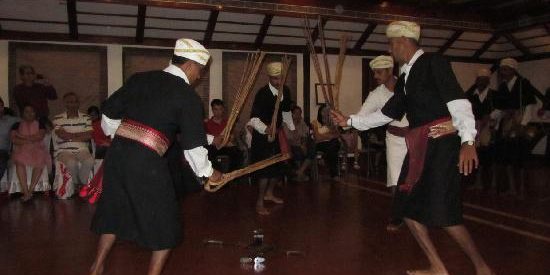
Folk Dances of Kodavas: “Huttari Dance” and “Bolak-aat” are dance forms of Kodagu. The Kodavas are a unique martial race, different in customs, traditions and religion from the surrounding populace. This is the annual harvest dance of the Kodavas. The men, dressed in traditional Kodava costumes with the decorative knife, perform this slow moving dance to background music. This dance has different varieties:
Bolak-aat
This is performed by the Kodava men in front of an oil lamp in an open field. The men hold the chavari(Yak fur) in one hand and the Kodava short sword “Odi-kathi” in the other while performing this dance. Many regional variations of this dance exist. Sometimes performers dance only with the chavari without the use of the short sword. When the “Odi-kathi” is also used, it is called kattiyaata. The dudi, an hourglass shaped drum is used to provide the rhythm for the dance.
Ummatt-aat
This is performed by the Kodava womenfolk. The women wear the traditional Kodava dress complete with jewelry, adorn the forehead with kumkuma and in a swinging rhythm, dance in a circle, brass cymbals in hand. One woman stands at the center holding a pot full of water to represent Kaveri taayi or Mother Kaveri, which the Kodavas worship as their prime deity.
Komb-aat
While the Bolaak-aat and the Ummattat are of a celebratory and festive nature, the Kombat is a dance performed with religious sentiments. It is traditionally performed in temple premises, but, in recent years, it is also performed in other places. This is a dance performed by the Kodava men and deer horns are used as a prop, representing the horns of the Krishnamruga, a spotted deer in Kodava legend.
The dance is performed to rhythmic tunes provided by wind instruments and percussion. The dance includes certain martial movements that represent some of the techniques used by the Kodavas in warfare.
Source: Wikipedia







